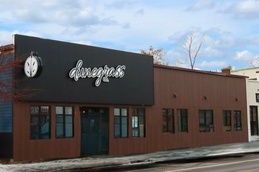
We Put Three Look & Feel-Better Methods to the Test
By Lynda Wheatley | March 31, 2018
I’m not a vain woman. But I am a profoundly lazy one. So the idea of any facial treatment, no matter how pricey or painful, that promises I’ll look good without makeup, intrigues me. Fact is, I’m 43 years old. My face sports wrinkles, pimples, unreasonable shades of red on and around my nose, and pores I suspect rival the size of Lake Superior’s basin. The problem? (Besides those aforementioned ones, anyway.) I loathe wearing makeup. The act of putting it on bores me. And frankly, I haven’t yet met a powder or cream that’s fooled anyone into thinking this face is flawless. So why bother?
Enter The Center for Plastic Surgery’s Halo Fractional Laser Treatment.
The Science
Promising to improve skin texture and tone, soften wrinkles and the appearance of large pores, and help with sun damage and discoloration. In other words, me. It uses two kinds of light lasers to create micro channels in the epidermis — the top layer of skin — and “create controlled zones of coagulation into the dermis” — the layer below — prompting new collagen production. Or, the Center’s Medical Esthetician Mischelle Fisher said, “You’re basically aerating your skin like a lawn.”
And I won’t lie. It feels like it.
Before I get into the treatment, I need to explain how I arrived at it. I entered the Center without a clue what I wanted — only complaints about what I didn’t. Before any treatment or product recommendations are made, your face is scanned with a Visia Complexion Analysis System, which takes funky photos and evaluates your skin in six key areas: sun damage, redness, pore size, texture, wrinkles, and spots.
In some ways, my results were startling. The image’s evaluation of my sun damage, which appeared to suggest my relation to an equator-dwelling lizard, only measured in at 36 percent. (Zero is best,100 is the worst. Most folks Up North, Fisher said, clock in under 20 percent.) Its evaluation of my pore size was woefully disheartening yet validating: Three percent. (Like I said, basin.) My texture? Much like the skin of an orange, Fisher told me — a good thing, because you have to have a thick skin to hear this stuff.
Afterward, she recommended two treatment options and detailed what each would — and would not — do. I signed on for the Halo, so named because it’s said to give you an angelic glow.
The Procedure
While the treatment doesn’t hurt like hell — you spread a numbing schmear of lidocaine on your face an hour before she rolls the fractionated laser (and a tiny hose of cool air) back and forth across your skin — it feels exactly as she warned me it would: Like a small, nonstop spray of Fourth of July sparklers on your face.
Strangely, my left cheek, which she started with, hurt significantly more than my right cheek or forehead, both of which were barely uncomfortable. Immediately afterward, I looked red-faced and slightly puffy, but more like I had been working out — except for telltale pinpricks of blood on my forehead and above my lips. That night I gently washed my face, applied loads of cream Fisher had given me, and didn’t bother with the recommended Advil; it didn’t hurt.
After
The next morning, a Friday, the area around my eyes and my cheekbones were puffier, and my face looked and felt wind-burned. I went to the office; nobody complained about my face. Over the weekend, I got “the MENDS” — microscopic epidermal necrotic debris — which is a fancy term for “teeny-tiny bronze scabs” that emerge all over your face, indicating that healing is underway. They became a little more dense and dark, and some started peeling away. It looked and felt like I was healing up from a bad sunburn. I went out in public several times. A few second glances, but no frightened stares.
By Monday, much of the MENDS had peeled away, save for some persistent hangers-on around my jaw and hairline. By the next weekend, I dare say I looked — well, not remotely angelic — but softer. My pores looked less noticeable. My skin tone looked significantly more even. And the texture? Akin to a baby’s rump.
Two weeks later, I’m pleased with the results, which Fisher said get even better over the next three months. The texture is remarkably soft. Minus my nose, which HALO can’t help, the tone seems even. My pores, while appearing smaller, remain angry little demons albeit less easily irritated. But, in line with my goal, I’m not wearing any makeup on my face, save for what I put on the occasional zit, of which I’ve only had two so far.
The best part, for me, has been something I didn’t expect or even know I’d appreciate: Besides the 10 minutes of morning makeup saved, I don’t worry about the combo of makeup and sweat if I work out at lunch. Ditto on sunscreen, which I’ve taken to slathering on my face every morning (30 second, tops) and reapplying (almost) as much as doctors recommend.
Final Assessment
For $1,350, the cost of the procedure is not something I could afford to do often, if even annually. But for deeper pockets who endure equally deep pores and shallow patience like mine, it’s definitely worth a roll. thecenterforyou.com
Pain-Free Michigan
High-intensity laser therapy
There’s something about the promise of being pain-free that seems too good to be true, especially once you’ve started down the road of middle age. Even with decent diet, exercise, and genetics, aren’t some things simply supposed to hurt now? I assume that all humans, unless they’ve been in climate-controlled storage for the first 40 years of their lives, eventually show signs of wear and tear. And so it’s been for me since I had my first child a little over three years ago.
In addition to joy, she brought me sciatica. About 10 weeks of physical therapy at the outset didn’t put a dent in the agony. And though it’s improved over the years through yoga and the occasional act of getting off my arse during the workday, it still rankles. Her little brother brought to my second pregnancy something else: aching feet, and specifically, a persistent, inexplicable pain under my right big toe if I walk or stand more than 10 minutes. It didn’t go away, as I’d expected, after his birth last year.
It was those two nagging issues I brought to Pain-Free Michigan, which claims to send high-power “laser light energy deep into the body” to reach and repair damaged cells and tissues.
Sound like a bunch of hooey? I know. I kind of thought so too.
The Science
Then I read some research and clinical studies. High-intensity laser therapy (HILT), which has only been around for about six years, has shown significant success in relieving pain in many chronic and acute conditions: tennis elbow, carpal tunnel, back pain, rotator cuff strain, and osteoarthritis of the knee and hips, to name a few. The athletic departments at the University of Michigan and Michigan State University use HILT for their athletes, as do professional sports teams. Efforts are even underway for hospitals to use HILT as an alternative to opioids for post-operative pain relief.
Whereas the more common low-level pain lasers in use today operate up to 500 milliwatts, Pain-Free Michigan’s HILT goes up to 60 watts. If the former are the equivalent of penlights, said Todd Hall, managing of Pain-Free Michigan, “Ours is essentially a high-beam floodlight.”
That’s not bluster; it’s physics. At 60 watts, Hall’s laser transmits 60 joules of energy per second, enabling it to penetrate more deeply and deliver, with more power and in less time, millions of photons to your tissue. Photons repair the damaged cells (those cut off from blood and oxygen) but cause no reaction in healthy (fully oxygenated) ones, and stimulate your body’s own response to reduce inflammation.
The Procedure
So where’d that leave me, my sore toe, and aching back? Lying flat with a pair of protective googles on my face while a pain therapist waved a small laser wand a few inches above and around each pain point for about 10 to 15 minutes. The sensation was warm and pleasant. I wanted to nap.
Hall said most people with an average pain condition see improvement within three sessions. I had the lower left quadrant of my back done twice, my toe three times. (Note: The latter was against Hall’s recommendation, who prefers to laser issues that have been diagnosed, such as my sciatica. I hadn’t seen a doctor about my aching toe. Hall told me if the source of the pain were something like a bone spur — not related to cell or tissue damage — the laser wouldn’t be much use.)
After
To Hall’s credit, the pain in my toe returned each night, usually after standing or walking about 30 minutes rather than 10. My sciatica, on the other hand, felt immediately, noticeably better after the first treatment. And its associated pain stayed away for over a week — until I got to a particularly rough week where I sat hunched at my computer all day at work, didn’t do any yoga whatsoever, and then spent the weekend wrangling my chunky one-year-old son and stubborn three-year-old daughter in and out of cars, cribs, beds, pajamas, high chairs, bathtubs, etc.
Perhaps not surprisingly, my sciatica reared its hibernating head, and well, I think I can safely say that, per my experience, HILT works — provided you a) apply it to pain that is officially diagnosed, b) follow the recommendations of your laser therapist, and c) support the treatment with a lifestyle that doesn’t aggravate the cause of the pain.
Final Assessment
For $175 for three treatments ($80 for a single; per-treatment cost lowers as package grow), I plan to try HILT again. But probably not until I’m done hefting chunky toddlers and working nine-hour stretches without moving. Painfreemichigan.com
Vital Health Scores
DEXA Scan
The drawback to undergoing back-to-back treatments for your face and body is that you spend a lot more time thinking and talking about your flaws, aches, and pain. A side effect I didn’t anticipate was not only feeling cruddy about my face and body but also becoming moderately obsessive about what I could “fix” next. Which is why I’m glad I saved my visit to Vital Health Scores for last.
Vital Health Scores doesn’t offer treatments or improvements of any kind. What it offers is a data-informed medical assessment of your bone density, body composition, cardiovascular system (from your abdominal aorta to your cranium), hearing, vision, average glucose levels, and more. In other words, if you’re wondering whether your bones are weak, your ticker is at risk of a stroke or attack, your lungs are inflamed or diseased, your thyroid is swollen, you’re headed toward diabetes, or how much your left thigh weighs — Vital Health Scores can tell you.
The practice is the brainchild of Medical Director Dr. Douglas Wigdon, a longtime board-certified family practice physician, and Technical Director Mark D. Zemanek, a clinical medical ultrasonographer, who also boasts several board certifications and decades of experience working and teaching in hospitals, clinics, and universities such as Stanford.
The pair makes for a powerful duo of hyper-experienced medical assessment and interpretation. They also offer something few physician practices can afford to these days: comprehensive and data-driven diagnostic exams and health screenings that are uber-affordable and require no prior authorization from your insurance company, plus substantial face-time talking to you about your concerns and results.
The Science
The technologies Dr. Wigdon and Zemanek use — among them, a dual-energy X-ray absorptiometry system (aka a DEXA full-body scanner), echocardiogram, A1c blood test, Spirometry lung capacity test, oxidative stress tests (which measure disturbances in the balance between the production of free radicals and antioxidant defenses) — isn’t newfangled, said Dr. Wigdon. They’re available in hospitals around the country. But therein lies the problem, as Dr. Wigdon and Zemanek see it; patients don’t have access to these vital screenings until they’re exhibiting outward symptoms that indicate a problem, their doctor gains permission from their insurance, and/or — worst case scenario — they’re already in the hospital.
The pair aim to remove the barriers to a patient’s preventative health efforts by helping them recognize, through evidence, what’s happening, unseen, inside. That said, I signed on for a DEXA scan, which assesses bone density and body composition.
The Procedure
I laid face up on the scanner table, silent and motionless, while a small rectangle rolled above (but not touching) me, from head to toe. Five minutes.
After
I learned I weigh 129.2 pounds. At 63 inches tall, 31.4 percent of me is fat. (Did I mention I had a baby last year?) But I learned something critical: There are different kinds of fat. My subcutaneous fat — the fat under my skin — isn’t a big deal. A typical hallmark of stroke and heart attack, the mass of my visceral adipose tissue (aka the fat surrounding your organs, which visibly thin people can have dangerous amounts of) was only .18 pounds. Zemanek called it “excellent.” Another reason to strut: My bone density was super strong for my age. For kicks, Zemanek also showed me a few bits beyond the basic DEXA scan: the inside of my carotid artery (no plaque or debris, excellent blood flow) and my heart (ditto).
Final Assessment
Getting a detailed breakdown of my body composition feels invaluable. It confirmed I’m doing some things right, and gives me a baseline if I ever find time to improve that body fat v. lean muscle composition, overall, or even if I just want to focus on the weight of my left leg (7.9 pounds of fat and 13.8 pounds of muscle, in case you were wondering). If my results indicated a worrisome direction, Dr. Wigdon and Zemanek would give me an actionable plan for change. The cost? $50, significantly cheaper than the thousands it’d cost me for this in a hospital, if my insurance even permitted it. If I wanted to undergo a screening for everything they offer, the comprehensive two-hour Executive Package, it’d top out at $500. Every other screening runs between $25 and $225. Vitalhealthscores.com
Trending

Michigan’s Marijuana Tax at Work
Cannabis has become a big business in northern Michigan, and local governments are putting tax dollars earned from dispensar… Read More >>
California Sober: Why People Are Switching from Alcohol to Weed
They call it “California sober.” Generally speaking, this term applies to folks who use marijuana but abstain f… Read More >>
The Legacy of Student Activism
“It’s a physical letter to your representative,” Alex Tank says when asked to define the word “prote… Read More >>


